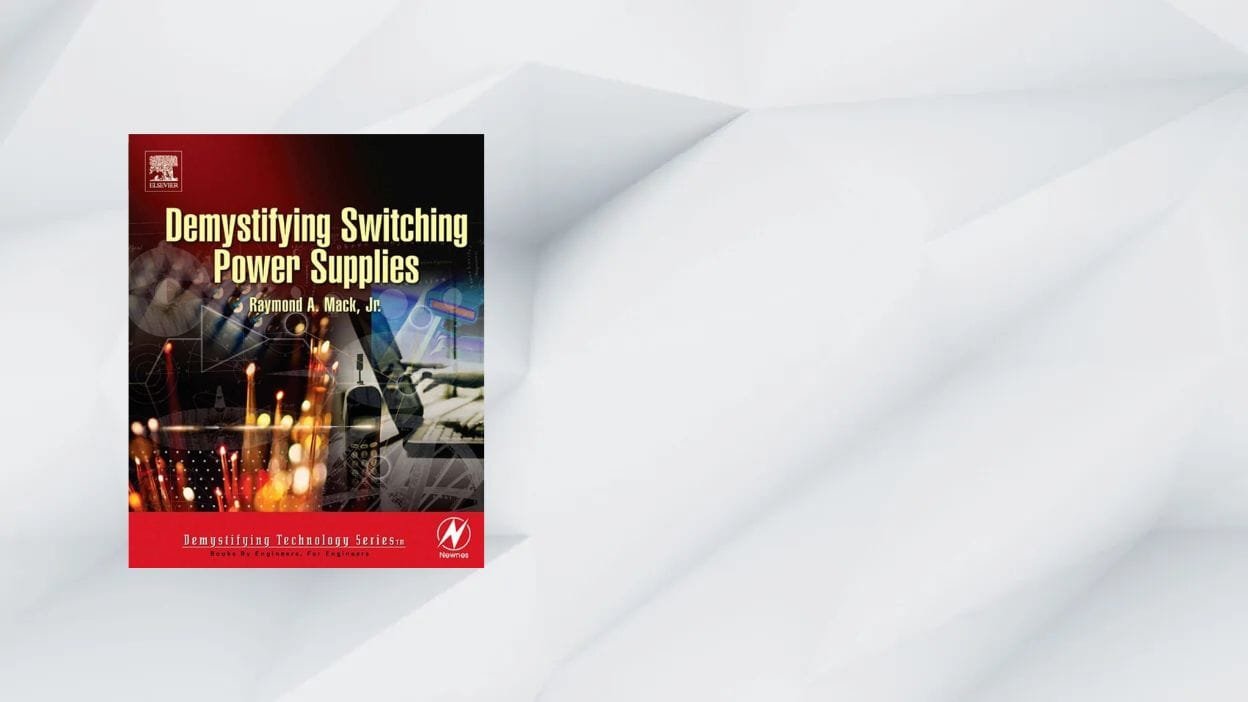Designing a robust SMPS can feel like voodoo: tiny mistakes cook MOSFETs, audible whine haunts prototypes, and EMI scans blow the budget. Demystifying Switching Power Supplies by Raymond A. Mack Jr. aims to bring order to that chaos. First published by Newnes/Elsevier in 2005 and weighing in at 323 pages, the book mixes entry-level theory with “buy-versus-build” wisdom for engineers selecting off-the-shelf converters. Two decades on, does it still earn a spot on your shelf? Let’s dive in.
Book at a Glance
| Full Title | Demystifying Switching Power Supplies |
| Author | Raymond A. Mack Jr. |
| Publisher / Year | Newnes (Elsevier) / 2005 |
| Print Length | 323 pp. (illustrated) |
| ISBN-13 | 978-0750674454 |
| Typical Price | US $45 new; US $15–30 used on Amazon/eBay |
| Core Audience | HW engineers, technicians, advanced makers, EE students |
| Focus Themes | Fundamentals, topology selection, off-the-shelf unit evaluation, troubleshooting |
Why Demystifying Switching Power Supplies Still Matters
- Theory without the PhD headache – Core concepts (inductor energy, duty-cycle math, ESR losses) use just enough algebra to explain behaviour, not intimidate.
- “Buy-or-build” realism – Unlike design-only tomes, Mack dedicates multiple chapters to spec-sheet reading, derating, and compliance checks when buying commercial power modules.
- Practical troubleshooting – Oscilloscope wave-shots flag common snags—subharmonic oscillation, shoot-through, transformer saturation—and propose quick fixes.
- Parts availability mindset – Examples feature jelly-bean controllers, TO-220 FETs, and standard ferrites still stocked today, so labs can replicate results.
Chapter Highlights
| Ch. | Key Topics | Take-Away Skills |
|---|---|---|
| 1 – 2 | Energy storage & switching basics | Translate volts-seconds to inductor selection |
| 3 | PWM vs. resonant topologies | Pick the right architecture for cost vs. EMI |
| 4 | Magnetics primer | Size ferrite cores, calculate A<sub>L</sub>, avoid saturation |
| 5 | Control & feedback | Design TL431-based opto loops; stability checkpoints |
| 6 | Rectification & output filtering | Ripple-current math, ESR selection tricks |
| 7 | Thermal management | Heatsink selection, convection vs. forced-air rules |
| 8 | Reading commercial SMPS datasheets | Efficiency curves, hold-up time, MTBF evaluation |
| 9 | Compliance & safety | IEC 60950 clearances, leakage, conducted/radiated EMI |
| 10 | Field troubleshooting | Fault-tree charts, signature waveforms, quick probe tips |
Strengths
- Balanced scope – Covers both custom design and COTS supply integration, a niche few books address.
- Illustrated explanations – Schematics and time-domain waveforms appear on facing pages, shortening the “mental cross-referencing” distance.
- Hands-on voice – Tips like “probe from source to drain, not gate to source, to see true switching loss” reveal an author who’s burnt a few FETs himself.
Limitations
| Limitation | Impact | Quick Fix |
|---|---|---|
| 2005 component data | MOSFET R<sub>DS(on)</sub> & controller options dated | Swap in modern GaN/SiC parts; math still applies |
| No USB-PD / PoE coverage | Lacks today’s protocol-rich supplies | Pair with recent “USB-C Power” application notes |
| Sparse digital control content | Analog PWM focus only | Supplement with TI or Microchip digital-PSU guides |
How It Compares
| Feature | Mack (2005) | Switching Power Supplies A-Z (Maniktala 2012) | SMPS Design Handbook (Billings 2014) |
|---|---|---|---|
| Pages | 323 | 430 | 880 |
| Math Intensity | ★★☆☆☆ | ★★★★☆ | ★★★★☆ |
| Buy-vs-Build focus | Strong | Minimal | None |
| Digital control | No | Brief | No |
| EMI & safety | Moderate | Moderate | Extensive |
| Best for | Fast ramp-up & COTS selection | Deep design dives | Reference-grade formulas |
SEO-Friendly FAQ
Is Demystifying Switching Power Supplies beginner-friendly?
Yes. High-school algebra suffices; advanced calculus is avoided.
Does the book show actual design examples?
Each chapter ends with a worked example—flyback, forward, buck—with calculations and parts lists you can breadboard.
Are modern GaN or SiC devices discussed?
Not explicitly (book predates them), but sizing formulas remain valid; just plug in today’s lower R<sub>DS</sub>(on) and Q<sub>g</sub> figures.
Where can I buy the book?
Elsevier’s store lists the paperback at US $45; used copies on Amazon/eBay run US $15–30.

